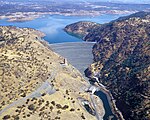New Melones Dam is an earth and rock filled embankment dam on the Stanislaus River, about 5 miles (8.0 km) west of Jamestown, California, United States, on the border of Calaveras County and Tuolumne County. The water impounded by the 625-foot-tall (191 m) dam forms New Melones Lake, California's fourth-largest reservoir, in the foothills of the Sierra Nevada east of the San Joaquin Valley. The dam serves mainly for irrigation water supply, and also provides hydropower generation, flood control, and recreation benefits.
The dam was authorized in 1944 as a unit of the federal Central Valley Project, a system designed to provide irrigation water to the fertile agricultural region of the Central Valley. It would be built by the U.S. Army Corps of Engineers (Corps), and transferred to the U.S. Bureau of Reclamation (Reclamation) upon completion. In 1966, work began to clear the foundations for a high dam that would replace an earlier, much smaller structure built by two irrigation districts. Construction of the main embankment began in 1976, and was topped out in late 1978. The filling of New Melones Lake began in 1978, and the dam's hydroelectric station produced its first power in mid-1979.
New Melones was the focus of a long environmental battle during the 1970s and early 1980s; critics protested the flooding of a long scenic stretch of the Stanislaus River, which flowed over whitewater rapids through the deepest limestone canyon in the western United States. The protestors employed a variety of methods, some extreme, to prevent the filling of New Melones Lake until 1983, when record-setting floods filled the reservoir and nearly breached the dam's emergency spillway. The fight over New Melones galvanized the river conservation movement in California and influenced major water policy changes on the state and federal levels; since its completion, no other dams of its size or importance have been built in the United States.The New Melones project has continued to generate controversy, due to the water yield from the project being lower than expected, and the use of New Melones water to meet federal environmental standards at the expense of farming. The reservoir is considered "over-allocated"; in an average year, it is unable to meet all the demands placed on it. The debate over water rights continues today, with environmentalists seeking to further increase fishery flows, and the Stanislaus irrigation districts asserting their senior rights to the river.






